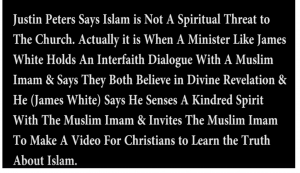Recognizing that this series might be illegal in Australia (and would certainly be so in any nation enslaved to Muslim law), we press forward in responding to our Muslim apologists who seek, through the use of what might charitably be identified as “scatter-gun” citations to sow as much doubt as possible concerning the nature of the canon of the Christian Bible. Recall how we have noted that this begs the question for the Muslim regarding their own Scriptures: the certainty one has regarding the canon of the Qur’ân is only as robust as the certainty one invests in the religio-military authority that defined it and maintained it. Our authors pull together a few examples from the period after the Reformation where ancient discussions (reflected in, for example, the Muratorian Fragment, or in the writings of Origen and Athanasius) resurfaced in the views of individuals or very small groups. But the fact remains, of course, that these instances do not represent a wide spectrum of opinion, and they did not have any lasting impact upon what had already been established over the course of the preceding centuries.
Next our writers again provide a less-than-balanced presentation regarding the search for an “Athanasian Codex.” This is derived from the chapter by Daryl Schmidt from TCU in The Canon Debate (Hendrikson, 2002). The subject of Schmidt’s work is The Greek New Testament as a Codex, and hence in the cited material he is discussing currently existing manuscripts that contain the exact listing as found by Athanasius in his 39th Festal Letter (A.D. 369). As such, it should immediately be recognized that our authors are, quite illegitimately, we believe, seeking to inculcate doubt once again through noting the fact that Greek NT manuscripts, being handwritten documents of ancient origin, are often in less than perfect states of repair. If you think your modern book’s binding is easily broken so that you can lose sections of the book, that is far more the case with hand written manuscripts where long-lasting binding technology was almost non-existent. Hence, while Schmidt’s inquiry is useful and interesting, the fact is that Athanasius knew the NT canon in the middle of the fourth century, and it is a large leap to conclude that since writing and binding technology was such that codices like Vaticanus are missing their last sections (it cuts off in Hebrews 9), or Sinaiticus and Alexandrinus contain other non-canonical books (which does not, we note in passing, indicate that those who produced said books believed those books were canonical–a major point to remember), that this substantiates the claim that the Bible as we possess it today did not pre-exist the days of Mohammed. It most assuredly did, even if writing technology was not such as to allow it to exist in a singular codex with regularity (and history, including weather and the ravages of war, likewise militates against the survival of such works from that far back in antiquity). But we have a hard time not identifying the following citation from our Islamic authors as simply misleading. They write,
In the concluding part of his paper, Schmidt quotes James’s Sanders who said:
It was becoming clear that there were probably as many canons as there were communities…. Focusing on the question of fluidity in the matter of inclusion/exclusion of different books in different communities in antiquity brought attention to the question of literature considered authoritative – that is, functionally canonical, by one Jewish or Christian community but not by another.
Why do I call this misleading? Let’s read what Schmidt actually said:
Many gaps remain in the information assembled here. Examination of additional microfilms could disclose surprises among manuscripts not otherwise studied for purposes of textual criticism. In the meantime, our provisional findings call to mind James Sanders’s observations on the contents of the Psalter in various Hebrew manuscripts:
It was becoming clear that there were probably as many canons as there were communities…. Focusing on the question of fluidity in the matter of inclusion/exclusion of different books in different communities in antiquity brought attention to the question of literature considered authoritative – that is, functionally canonical, by one Jewish or Christian community but not by another.
The Sanders quote is about the Psalter, not the New Testament (the context in which it is placed by Saifullah and Azmy). Schmidt then went on to say, “I want to endorse at least this part of Sanders’s approach to the question of canon” (referring to a desire to see what believing communities actually had available to them). This is hardly an unqualified endorsement en toto, and the entirety of the citation is not about the NT to begin with. There simply is no reason to pile citation upon citation like this by ignoring the original context.
Saifullah and Azmy then move farther into less-than-accurate reporting when they write, “As far as Codex Vaticanus (c. 350 CE) is concerned, the Pastoral Epistles and Revelation are nowhere to be seen.” Given that Vaticanus cuts off at Hebrews 9:13, does it not follow rather logically that the manuscript has lost its final section (a common enough problem, found in numerous instances)? This is relevant to serious argumentation? They continue: “If we were to include the books of the Old Testament present in these Greek manuscripts, the case gets irredeemable for demonstrating the Christian “scriptures” being the same today as in Muhammad’s time. Shall we also point out the well-known fact that no two manuscripts of the New Testament anywhere in existence are alike?” Two quick comments: how would anything relevant to the OT Canon in the LXX at all impact the reality that these books were written and functional in the church (as witnessed by the entirety of the patristic literature)? We are not told. Secondly, it is not indicative of serious scholarship to make the statement, “no two manuscripts of the New Testament anywhere in existence are alike” solely for the purpose of creating confusion rather than providing clarity. I, for one, find such misuse of history greatly offensive, let alone simply misleading. Is the statement, on it’s face, true? Yes, it is, if by that you mean, “No two hand-written documents in antiquity of major length are identical in every respect.” But then again, that is true of every single document of antiquity, including, of course hand-written documents of the Qur’ân: handwritten documents contain copyist errors, even when they are of the smallest order. The concern for the truthful individual is, “Do the variations in the manuscripts mean the original readings have been lost?” and the answer to that is a hearty “no.”




